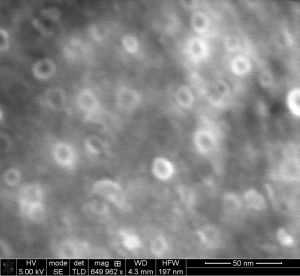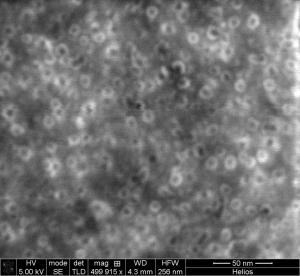Improved Carbon Nanotube Ultracapacitor Electrodes for Storage
- Category: Energy, Materials, Nanotechnology
- Tags: david jenicek, john kassakian
Due to their mechanical, thermal, and electrical properties and their natural ability to grow on a variety of metallic and nonmetallic substrates[1], carbon nanotubes (CNTs) have the potential to significantly enhance the performance of modern ultracapacitors[2],[3]. However, the energy density of these devices – the relevant metric for energy storage applications – still falls far below (about 20x) that of modern lithium-ion batteries. We are investigating different fabrication techniques that enhance electrode energy density to make ultracapacitors more competitive. Two specific goals are (1) achieving an elevated count of CNTs per unit area to increase the specific surface area of each electrode, which can be achieved by modifying the morphology of catalyst particles on the substrate prior to CNT growth, and (2) investigating various surface treatment techniques such as plasma or acid/base etching, chemical functionalization, or coating to increase the incremental capacitance of each CNT.
The growth of CNTs is initiated when a uniform thin layer of catalyst material is heated and dewets from the substrate to form well-distributed nanoparticles, which are then subjected to a carbon-containing gas. To date, we have demonstrated that the density of CNTs can be varied to a factor of about 10x simply by changing the thickness of the initial catalyst layer. Figures 1 and 2 are SEM images of differently prepared substrate surfaces after the removal of CNTs. Each circle shows the location where a CNT used to be. The density of CNTs in Figure 2 is approximately 5x higher.
- Figure 1: SEM of electrode surface after removal of CNTs, showing a CNT density of approximately 9 x 1010 cm-2.
- Figure 2: SEM image of electrode surface after removal of CNTs, showing a CNT density of approximately 4 x 10 11 cm -2.
- J. A. Hart, “Chemical, Mechanical, and Thermal Control of Substrate-Bound Carbon Nanotoube Growth,” Ph. D. thesis, Massachusetts Institute of Technology, Cambridge, 2006. [↩]
- R. Signorelli, “High energy and power density nanotube-enhanced ultracapacitor design, modeling, testing, and predicted performance,” Ph.D. thesis, Massachusetts Institute of Technology, Cambridge, 2009. [↩]
- Signorelli, R. et al. “Electrochemical Double-Layer Capacitors Using Carbon Nanotube Electrode Structures,” in Proceedings of the IEEE, vol. 97.11, pp. 1837-1847, 2009. [↩]

